Art of the Book Exhibit Currently On View in Cohen Atrium
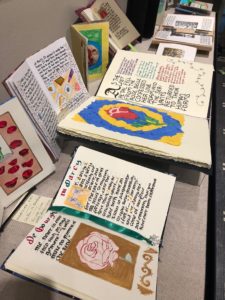 An imaginative, vibrant exhibit on view through mid-July in the atrium-level display cases of Cohen Memorial Hall are the handmade books created and decorated by the students of Elizabeth Moodey, associate professor of history of art, for her HART 2288 course, Art of the Book.
An imaginative, vibrant exhibit on view through mid-July in the atrium-level display cases of Cohen Memorial Hall are the handmade books created and decorated by the students of Elizabeth Moodey, associate professor of history of art, for her HART 2288 course, Art of the Book.
“Illuminated manuscript (literally “handwritten”) books are arguably the most characteristic objects of the European middle ages, but contemporary artists have also responded to the challenge of making a book by hand,” said Moodey. “Inspired by those traditions, each of the students chose a favorite text and acted as both patron and artisan for the books on display.”
In the course of the spring semester Moodey and her students considered the changing material and visual make-up of medieval illuminated manuscripts, and through them questions of literacy and audience, the mutation and popularity of certain texts and illustrations, the various contributions of script and picture, and the concerns of patron and artist. They explored how much the impact of a work depends on the arrangement of words on the page, looking at examples from medieval grid-poems and pictorial initials, the Arts and Crafts revival of the book arts, Dada and Futurist publications, and contemporary artists’ books. The class worked with medieval and modern material in Vanderbilt’s Special Collections.
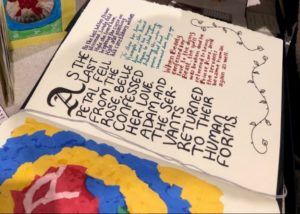 “While the project was still an abstract idea,” said Elizabeth Ojo, BA’19, “It was easy for me to make assumptions of how much I could accomplish and how the book would look. Once I bought the materials and had to physically measure and cut the pages, I realized how complicated the process actually is. Our class lecture on techniques reminded me that ‘images interpret as much as they depict.’ Stories have this freedom to tell the reader about the artist’s environment or tradition during that time period. Telling different versions of ‘Beauty and the Beast’ allowed me to focus on this lecture and flesh out text that was connected to one another.”
“While the project was still an abstract idea,” said Elizabeth Ojo, BA’19, “It was easy for me to make assumptions of how much I could accomplish and how the book would look. Once I bought the materials and had to physically measure and cut the pages, I realized how complicated the process actually is. Our class lecture on techniques reminded me that ‘images interpret as much as they depict.’ Stories have this freedom to tell the reader about the artist’s environment or tradition during that time period. Telling different versions of ‘Beauty and the Beast’ allowed me to focus on this lecture and flesh out text that was connected to one another.”
Ojo’s opening of Beauty and the Beast: A Collection of Retellings synthesizes the conclusions of the four versions featured in this retelling. However, while Disney and HBO’s Beauty lives happily ever after, the others diverge from the traditional happy ending.
 Other students exhibiting their handmade books are Bethany Boggs, ’21, The Yellow Wallpaper; Delaney Houston, ’20, A Pairing; Carly Martinez-Don, ’21, La Rose: Extraits de Le Petit Prince; Kassie Dooley-Smith, ’20, Revelations throughout Pride and Prejudice; Daniel Freedland, ’19, The Sun Also Rises; Victoria Spiliopoulos, ’19, The Backyard Table; Sophia Rademaker, ’21, Cautionary Tales for Children: Jim; Katy Roach,’19, Letters to My Daughter/Letters to My Dad; Joe Eilbert,’19, Kids These Days; Sydney Kaemmerlen, ’20, Diary of a Narcoleptic; Emily Jordan, ’21, Two Brothers; Maris Paden, ’19, Excerpts from Ernest Hemingway’s The Sun Also Rises and The Garden of Eden; and Ali WIlt, ’20, The Kentucky Derby is Decadent and Depraved.
Other students exhibiting their handmade books are Bethany Boggs, ’21, The Yellow Wallpaper; Delaney Houston, ’20, A Pairing; Carly Martinez-Don, ’21, La Rose: Extraits de Le Petit Prince; Kassie Dooley-Smith, ’20, Revelations throughout Pride and Prejudice; Daniel Freedland, ’19, The Sun Also Rises; Victoria Spiliopoulos, ’19, The Backyard Table; Sophia Rademaker, ’21, Cautionary Tales for Children: Jim; Katy Roach,’19, Letters to My Daughter/Letters to My Dad; Joe Eilbert,’19, Kids These Days; Sydney Kaemmerlen, ’20, Diary of a Narcoleptic; Emily Jordan, ’21, Two Brothers; Maris Paden, ’19, Excerpts from Ernest Hemingway’s The Sun Also Rises and The Garden of Eden; and Ali WIlt, ’20, The Kentucky Derby is Decadent and Depraved.
Cohen Memorial Hall is on the western edge of the Peabody College campus. Parking is available anywhere in Lot 95, accessible from 21st Avenue South.
*Photographs courtesy of the Vanderbilt Fine Arts Gallery and Elizabeth Moodey
Posted by vrcvanderbilt on June 18, 2019 in Fine Arts Gallery, HART, News, Student/Alumni, Vanderbilt University, VRC
HART Graduate Maris Paden Travels on a Downing Grant to View Vigée Le Brun’s Paintings
 I had the honor of receiving a 2019 Downing Grant to supplement my research for the advanced seminar, HART4960: Art & Politics during the Revolutionary and Napoleonic Era. My focus was the career of the eighteenth-century French painter Élisabeth Vigée Le Brun during her stay in Italy. The Downing grant enabled me to travel to Washington DC as well as New York City during my spring break.
I had the honor of receiving a 2019 Downing Grant to supplement my research for the advanced seminar, HART4960: Art & Politics during the Revolutionary and Napoleonic Era. My focus was the career of the eighteenth-century French painter Élisabeth Vigée Le Brun during her stay in Italy. The Downing grant enabled me to travel to Washington DC as well as New York City during my spring break.
I visited the National Gallery, the National Museum for Women in the Arts, and the Metropolitan Museum of Art to see firsthand the works of Vigée Le Brun. Additionally, I spent an afternoon at The Phillips Collection, MoMA and The Frick Collection. To pursue my love of art history and represent Vanderbilt in two such phenomenal cities was a dream come true.
Due to her monarchical ties, Vigée Le Brun’s life was threatened by revolutionary violence in 1789. The painter took the political and social unrest as an optimal opportunity to fulfill her long-held dream of studying in the artistic capital of Rome. She embarked on what would become a twelve-year journey, painting portraits in mostly aristocratic circles across Europe. Her stay in Italy (1789 to 1792) marked a highly prolific period for the artist where she produced many of her most well-known works.
To Vigée Le Brun, as with many artists before her, Rome embodied the very ideal of classical art. She was invigorated by the works of Correggio, Michelangelo, and Raphael, among others, as well as the landscape of Mount Vesuvius, the gardens of Tivoli, and more. Her style was both fortified and transformed by her years in Italy. The new setting offered her not only refuge but also an opportunity to challenge herself among the great masters. Her canvases from this period greatly bolstered the artist’s reputation and career.
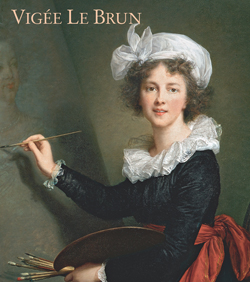 Though we can learn much through the available literature on the artist, the experience of viewing a painting in person is unrivaled. The ability to be inches from the very canvas that this figure breathed upon is invigorating and offers an unparalleled intimacy. As I analyze and internalize her brush strokes and palette, I am transported through the centuries. For a brief instant, Vigée Le Brun is not more than two hundred years deceased. She and I exist in the same moment of time and connect through the tangible masterpiece before my eyes. From the confines of her frame, her vitality supersedes the bounds of physics and reaches me. It is this ethereal experience that powered me through my research. It is this transportive quality that compels me toward the fine arts day after day. It is this didactic passion that the Downings foster in their grantees.
Though we can learn much through the available literature on the artist, the experience of viewing a painting in person is unrivaled. The ability to be inches from the very canvas that this figure breathed upon is invigorating and offers an unparalleled intimacy. As I analyze and internalize her brush strokes and palette, I am transported through the centuries. For a brief instant, Vigée Le Brun is not more than two hundred years deceased. She and I exist in the same moment of time and connect through the tangible masterpiece before my eyes. From the confines of her frame, her vitality supersedes the bounds of physics and reaches me. It is this ethereal experience that powered me through my research. It is this transportive quality that compels me toward the fine arts day after day. It is this didactic passion that the Downings foster in their grantees.
I am forever indebted to the History of Art Department for cultivating in me an insatiable appetite for the arts. It propelled my love of museums into an academic sphere where I want to spend the majority of my time. From our breathtaking classrooms of Cohen Memorial Hall, to the outstanding faculty, to the support of the Downing family, my four years in the department have fundamentally changed me as a student, a thinker, and an individual. I offer my most sincere thank you to the Downings for their generosity, and to my advisor and mentor, Prof. Christopher Johns. I too hope that one day I am able to give back to the department that has done so much for me.—Maris Paden, BA’19 (history of art and medicine, health & society)
Posted by vrcvanderbilt on June 14, 2019 in HART, News, Student/Alumni, Vanderbilt University, VRC
Rebecca VanDiver Receives 2019 Millard Meiss Publication Fund Award
Rebecca VanDiver, assistant professor of African American art, recently received a Millard Meiss Publication Fund Award. Two times each year, the College Art Association (CAA) awards grants to publishers in art history and visual culture to support presses in the publication of projects of the highest scholarly and intellectual merit that may not generate adequate financial return.
The Pennsylvania State University Press is publishing her book-length manuscript on the artist Loïs Mailou Jones in 2020 under the title Negotiating Traditions: Loïs Mailou Jones and the Composite Aesthetics of Blackness. One of twelve Meiss grantees for spring 2019, VanDiver teaches courses on modern/contemporary African American and African art and visual culture. Her research, centered on 20th-century black women artists, African American artistic engagements with Africa, and the politics of exhibition and display, has appeared in American Art, Archives of American Art Journal, Space and Culture, Callaloo, and Transition.
Posted by vrcvanderbilt on June 14, 2019 in HART, News, Vanderbilt University, VRC
Fine Arts Gallery Features Ceramics of Susan DeMay June 13-September 13
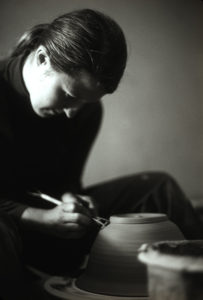 Susan DeMay began pursuing ceramics as a graduate student at what was then called the George Peabody College for Teachers, where she studied art from 1977 to 1979. After earning her M.S. degree and establishing a pottery studio of her own, she was invited to return to the Vanderbilt campus to teach. Nearly forty years later, she will be celebrating her retirement as a professor in Vanderbilt’s Department of Art. Opening June 13 in the Vanderbilt University Fine Arts Gallery in Cohen Memorial Hall, Divergent Practices: A Career in Ceramics surveys ceramics that DeMay, principal senior lecturer, produced over decades of teaching, running her own production line, and creating artwork in clay.
Susan DeMay began pursuing ceramics as a graduate student at what was then called the George Peabody College for Teachers, where she studied art from 1977 to 1979. After earning her M.S. degree and establishing a pottery studio of her own, she was invited to return to the Vanderbilt campus to teach. Nearly forty years later, she will be celebrating her retirement as a professor in Vanderbilt’s Department of Art. Opening June 13 in the Vanderbilt University Fine Arts Gallery in Cohen Memorial Hall, Divergent Practices: A Career in Ceramics surveys ceramics that DeMay, principal senior lecturer, produced over decades of teaching, running her own production line, and creating artwork in clay.
On view through September 13, the exhibition showcases selections from three bodies of work that DeMay has developed over the years. The first are pieces made for classroom demonstrations, which underscore technical methods as well as aesthetic considerations. The second group represents the colorful production works that DeMay fabricated while running a pottery business, with the help of up to nine assistants. The third includes a suite of ceramics that are slab-constructed forms with unique surface treatments and hard, glassy glazes. These artworks are inspired by a wide-ranging set of visual references, as well as traditional ceramic practices.
At her closing artist talk, “Making and Teaching Ceramics: Not Just for Fun,” on August 9, DeMay will discuss her work and life, expanding on why making and teaching ceramics were not “just for fun”—a phrase she encountered often in her long and multifaceted career. The talk will begin at 5 pm in Cohen Memorial Hall, room 203, with a reception to follow in the atrium.
The Fine Arts Gallery is located in Cohen Memorial Hall at 1220 21st Avenue South, on the western edge of the Peabody College campus. Parking is available anywhere in Lot 95 on the Peabody campus, accessible from 21st Avenue South.
Gallery hours for the summer (now through August) are Tuesday-Friday, noon to 4 pm; Saturday, 1-5 pm; closed Sunday and Monday.
*Kinchi Fukumoto. Susan DeMay trimming a bowl in her studio at Peabody College, 35mm slide (reproduction), 1978.
Posted by vrcvanderbilt on June 11, 2019 in Events, Fine Arts Gallery, HART, Lectures, News, Vanderbilt University, VRC
Matthew Worsnick to Present Paper at Université Libre de Bruxelles
Partly inspired by the publication of Jan Gross’s book Neighbors: The Destruction of the Jewish Community in Jedwabne, Poland more than fifteen years ago, historians, social scientists, linguists and other observers of eastern Europe have recently produced exciting studies about coexistence, conflict and why violence unfolds in specific spaces at precise moments. They seek to answer what is, according to historian John Connelly, the most vexing question for Poland and the entirety of east central Europe: “How (did) ethnic communities that had coexisted more or less peacefully for generations, often in fruitful cross-pollination (dissolve) in fear, hate and recrimination from the middle of the 20th century onward?”
Matthew Worsnick, assistant professor of the practice of art history, will present his paper entitled “Mapping the Margins: National borders, transnational networks, and images of coherence in Italy and Yugoslavia” on June 11 at the Université Libre de Bruxelles. The overall theme is “Neighbors? Relationships and Rootedness in Eastern Europe across the 20th Century.”
The workshop has assembled an interdisciplinary group of scholars, Worsnick among them, who are experts in urban planning, political science, social anthropology and history. Sponsors are the Université Libre de Bruxelles, the Fulbright Commission for Educational Exchange between the United States of America, Belgium and Luxembourg, and the Institute of Slavic, East European, and Eurasian Studies at the University of California, Berkeley.
Posted by vrcvanderbilt on June 11, 2019 in Conferences, Events, HART, News, Vanderbilt University, VRC
Imaging Team Replicate Ancient Mesoamerican Artifacts for Gallery Exhibit
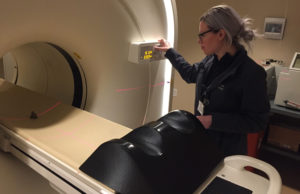 When the Vanderbilt University Institute of Imaging Science (VUIIS) installed a new, state-of-the-art PET/CT scanner in early 2018, the team imagined a wide range of research opportunities — but none of them involved imaging artifacts for an art gallery exhibition.
When the Vanderbilt University Institute of Imaging Science (VUIIS) installed a new, state-of-the-art PET/CT scanner in early 2018, the team imagined a wide range of research opportunities — but none of them involved imaging artifacts for an art gallery exhibition.
This spring the VUIIS partnered with Vanderbilt’s Fine Arts Gallery to scan and create replicas of ancient Mesoamerican artifacts for a hands-on experience in the gallery’s current exhibition, Refuting “Noble Savages:” Reflections of Nature in Ancient Mesoamerican Artifacts.
Using the scanner, the imaging team captured detailed pictures of each item’s surface and openings and sent the data to a 3D printer to print polymer replicas. Some of the replicas were then painted by undergraduate students in Markus Eberl’s spring semester course (Exhibiting Historical Art—Daily Life in Mesoamerica) to look like the original objects.
 Three replicas were created for the student-curated exhibition: an ancient flute and two ink stamps with varying designs.
Three replicas were created for the student-curated exhibition: an ancient flute and two ink stamps with varying designs.
“The Fine Arts Gallery has to secure its artifacts behind glass, so 3D replicas help us make these objects accessible to visitors,” said Eberl, associate professor of anthropology. “They can pick up the flute and play it. They can ink stamp replicas to reproduce the patterns engraved on the original stamps.”
“It’s a way for visitors to get closer not only to the objects, but also to the psychology and experiences of the people who originally used them,” added Emily Weiner, assistant curator of the Fine Arts Gallery.
According to Seth Smith, associate professor of radiology and radiological sciences and associate director of VUIIS, the collaboration demonstrates how imaging technology extends beyond clinical research, allowing the institute to be a resource for the greater Vanderbilt community.
“It was exciting for us to partner with the Fine Arts Gallery to do something completely out of the box. We were excited to develop a new relationship brought about because of the existence of a new imaging device within VUIIS. This is a bridge we don’t often get to see, and personally, I find it to be fascinating and encouraging,” said Smith.
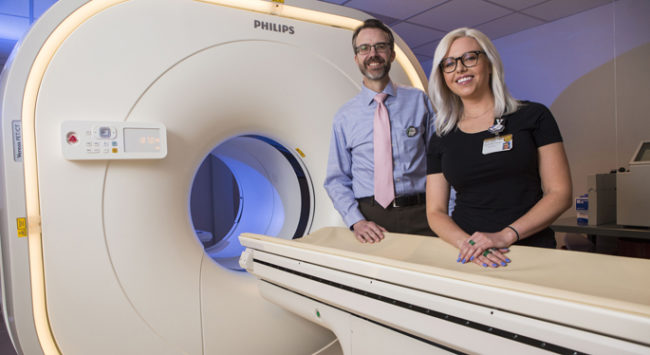 “It is exciting that our imaging technology can contribute not only to human health and the study of biological systems, but also to the humanities and our appreciation of ancient cultures,” said Todd Peterson, director of nuclear imaging. “While it may seem like a small detail, combining our tomographic imaging capabilities with 3D printing provides a true reproduction of these objects in a way that simply tracing the outer contours couldn’t.”
“It is exciting that our imaging technology can contribute not only to human health and the study of biological systems, but also to the humanities and our appreciation of ancient cultures,” said Todd Peterson, director of nuclear imaging. “While it may seem like a small detail, combining our tomographic imaging capabilities with 3D printing provides a true reproduction of these objects in a way that simply tracing the outer contours couldn’t.”
The partnership also allowed the team to learn more about the device’s capabilities. “This project was especially valuable as it provided the opportunity to test different aspects of our scanner’s imaging and reconstruction software which had not been previously explored,” said Anna Fisher, CNMT, nuclear medicine PET technologist II.
“We were able to acquire high-resolution CT images of each piece and successfully convert the data into 3D-printable formats all from the scanner itself. Discovering these unique capabilities has opened the door to new services we can provide here at VUIIS.”
The exhibition is on display through September 13 in the Vanderbilt Fine Arts Gallery in Cohen Memorial Hall on the western edge of the Peabody College campus. Gallery hours for the summer (now through August) are Tuesday-Friday, noon to 4 pm; Saturday, 1-5 pm; closed Sunday and Monday.—Kelsey Herbers courtesy of VUMC Reporter (May 9, 2019)
*Anna Fisher, certified nuclear medicine technologist, scans an ancient stamp using the PET/CT scanner. *Todd Peterson, director of nuclear imaging, and Fisher oversee the operation of the new research PET/CT scanner. (photos by Anne Rayner)
Posted by vrcvanderbilt on June 7, 2019 in Digital Humanities, Events, Fine Arts Gallery, HART, News, Student/Alumni, Technology, VRC
Student-Curated Gallery Exhibit Features Ancient Mesoamerican Artifacts
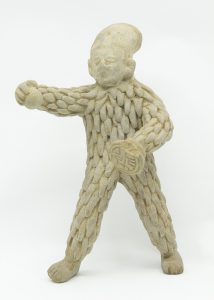 Held in conjunction with the celebration of our 2019 HART graduates was the opening reception for a student-curated exhibition entitled Refuting “Noble Savages:” Reflections of Nature in Ancient Mesoamerican Artifacts. On view through September 13, the exhibit features a collection of ancient Latin American artifacts curated by undergraduate students as part of a semester-long course (Exhibiting Historical Art—Daily Life in Mesoamerica) taught by Markus Eberl, associate professor of anthropology. The exhibition focuses on the connection between nature and culture among pre-Columbian Mesoamerican peoples (ca. 500 to 1500 CE), with the artifacts on view elucidating their daily life and beliefs.
Held in conjunction with the celebration of our 2019 HART graduates was the opening reception for a student-curated exhibition entitled Refuting “Noble Savages:” Reflections of Nature in Ancient Mesoamerican Artifacts. On view through September 13, the exhibit features a collection of ancient Latin American artifacts curated by undergraduate students as part of a semester-long course (Exhibiting Historical Art—Daily Life in Mesoamerica) taught by Markus Eberl, associate professor of anthropology. The exhibition focuses on the connection between nature and culture among pre-Columbian Mesoamerican peoples (ca. 500 to 1500 CE), with the artifacts on view elucidating their daily life and beliefs.
This exhibition challenges the term “noble savages,” a reference to Western portrayals of ancient Mesoamerican peoples in a subdued and romanticized form. In reusing this out-of-date term, the student-curators aim to draw attention to its racially-charged connotation, while presenting an opposing view that focuses on the diversity of everyday practices in Mesoamerica. City dwellers and farmers, mothers and children, ballplayers and creators are all showcased here. Their lives were grounded in sophisticated religious beliefs and exquisite knowledge of their environment.
 Eberl and the Fine Arts Gallery staff collaborated with the Vanderbilt University Institute of Imaging Science (VUIIS) to scan and replicate three objects from the exhibit. With the inclusion of interactive elements, including 3D artifact-replicas that invite hands-on discovery, the viewer is invited to join us in a multi-sensory exploration of ancient Mesoamerica.
Eberl and the Fine Arts Gallery staff collaborated with the Vanderbilt University Institute of Imaging Science (VUIIS) to scan and replicate three objects from the exhibit. With the inclusion of interactive elements, including 3D artifact-replicas that invite hands-on discovery, the viewer is invited to join us in a multi-sensory exploration of ancient Mesoamerica.
This student-curated exhibition is the result of a partnership between the Department of History of Art and the Vanderbilt University Fine Arts Gallery. The undergraduate students include Baha Aydin, Kaitlin Joshua, Elsa Mueller, Kirsten Nafziger, Bella Smith, Sophie Stark, Yunyang Zhou, and Michelle Zhu. 3-D imaging and printing of ancient artifacts was made possible thanks to Anna Fisher, John Gore, Todd Peterson, Seth Smith, and Ken Wilkins at the Vanderbilt University Institute of Imaging Science. Other sponsors are the Department of Anthropology, the Department of History of Art, and the Center for Latin American Studies.
The Fine Arts Gallery is located in Cohen Memorial Hall at 1220 21st Avenue South, on the western edge of the Peabody College campus. Parking is available anywhere in Lot 95 on the Peabody campus, accessible from 21st Avenue South.
Gallery hours for the summer (now through August) are Tuesday-Friday, noon to 4 pm; Saturday, 1-5 pm; closed Sunday and Monday.
*Ball Player in Warrior Bird Costume, Pre-Columbian, Classic Period, 600–800 CE, The Marjorie and Leon Marlowe Collection, Vanderbilt University.
**The Imaging Institute scanned the ancient flute, top, and created a 3D-printed replica, below, which was then painted by Eberl’s undergraduate students.
.
Posted by vrcvanderbilt on June 7, 2019 in Digital Humanities, Fine Arts Gallery, HART, News, Student/Alumni, Technology, Vanderbilt University, VRC
Sheri Shaneyfelt Leads Denver Commodore Classroom in Study of Leonardo da Vinci
 The Denver Museum of Nature & Science provided the perfect setting for a May 2019 Commodore Classroom featuring Sheri Shaneyfelt, principal senior lecturer of the history of art and director of undergraduate studies, and the current exhibit Leonardo da Vinci: 500 Years of Genius. Shaneyfelt joined the Denver Vanderbilt Alumni Chapter on May 19 to discuss the extraordinary life and legacy of Leonardo da Vinci, inventor, artist, scientist, anatomist, engineer, architect, sculptor, and philosopher.
The Denver Museum of Nature & Science provided the perfect setting for a May 2019 Commodore Classroom featuring Sheri Shaneyfelt, principal senior lecturer of the history of art and director of undergraduate studies, and the current exhibit Leonardo da Vinci: 500 Years of Genius. Shaneyfelt joined the Denver Vanderbilt Alumni Chapter on May 19 to discuss the extraordinary life and legacy of Leonardo da Vinci, inventor, artist, scientist, anatomist, engineer, architect, sculptor, and philosopher.
On view through August 25, the exhibit blends art and technology into a symphony of light, color and sound, creating breathtaking effects that bring Leonardo’s works to life.
Posted by vrcvanderbilt on June 5, 2019 in Events, HART, Lectures, News, Student/Alumni, Vanderbilt University, VRC
Matthew Worsnick Awarded Fellowship at the Wolfsonian-Florida International University
 Matthew Worsnick, assistant professor of the practice of art history, was recently awarded a residential fellowship at the Wolfsonian-Florida International University, Miami Beach, for the summer of 2020. The fellowship program supports projects from a wide range of academic fields to promote scholarly research on The Wolfsonian’s collection. Fellowships are awarded for full-time research at the museum, generally for periods of 3–4 weeks.
Matthew Worsnick, assistant professor of the practice of art history, was recently awarded a residential fellowship at the Wolfsonian-Florida International University, Miami Beach, for the summer of 2020. The fellowship program supports projects from a wide range of academic fields to promote scholarly research on The Wolfsonian’s collection. Fellowships are awarded for full-time research at the museum, generally for periods of 3–4 weeks.
The Wolfsonian-FIU collections include objects dating from 1885 to 1945 that illustrate “the persuasive power of art and design, to explore what it means to be modern, and to tell the story of social, political, and technological changes that have transformed our world. It encourages people to see the world in new ways, and to learn from the past as they shape the present and influence the future.”
Trained as an architect (MA, Columbia) and an architectural historian (PhD, New York University), Worsnick teaches courses in design studies, global architectural history, memorials, and the architect’s toolkit. His research explores the use of built space for political aims, both in the contexts of New York City and in southeastern Europe. He is currently revising a book manuscript, tentatively entitled, “Ambivalent Lines: Urban and Architectural Appropriations in Contested Italo-Yugoslav Territories, 1918-1954,” which explores the ways that those in Fascist Italy and Yugoslavia employed strategies of architecture to claim contested territory.
As a Mellon Foundation Fellow in MoMA’s Department of Architecture and Design, Worsnick worked on the exhibition, “Toward a Concrete Utopia: Architecture in Yugoslavia, 1948-1980,” and contributed to a companion volume published to coincide with the exhibition (July 15, 2018-January 13, 2019).
Posted by vrcvanderbilt on June 5, 2019 in HART, News, Vanderbilt University, VRC
Rebecca VanDiver Named a Nancy Weiss Malkiel Scholar
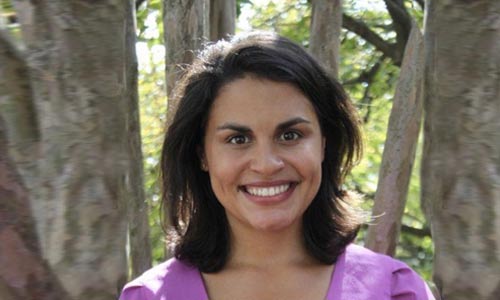 Rebecca VanDiver, assistant professor of African American art, has been named one of ten Nancy Weiss Malkiel Scholars for 2019 through the Woodrow Wilson National Fellowship Foundation. The Malkiel Scholars Award, funded by The Andrew W. Mellon Foundation, is given to junior faculty whose research focuses on American history, politics, culture, and society, and who are committed to the creation of an inclusive campus community for underrepresented students and scholars.
Rebecca VanDiver, assistant professor of African American art, has been named one of ten Nancy Weiss Malkiel Scholars for 2019 through the Woodrow Wilson National Fellowship Foundation. The Malkiel Scholars Award, funded by The Andrew W. Mellon Foundation, is given to junior faculty whose research focuses on American history, politics, culture, and society, and who are committed to the creation of an inclusive campus community for underrepresented students and scholars.
Each Malkiel Scholar receives a twelve-month award that seeks to free the time of junior faculty on their way to tenure—including those from underrepresented groups and others committed to eradicating disparities in their fields—so that they can both engage in and build support for systems, networks, and affinity groups that make their fields and campuses more inclusive.
VanDiver is in the early stages of research for her second book manuscript on twentieth-century African American art that addresses the notion of impermanence. Her working title is States of Emergency: Politics of Ephemerality in African-American Art Practices, 1965–2015.
“In this new project, I will examine the ways in which African American artists working during the past 50 years have engaged with ideas of ephemerality, producing temporary materials like prints and posters as well as larger-scale projects, like site-specific community murals,” VanDiver said. “An example of that would be the Wall of Respect that existed on Chicago’s South Side from 1967 to 1981.”
Posted by vrcvanderbilt on June 5, 2019 in HART, News, Vanderbilt University, VRC

©2024 Vanderbilt University ·
Site Development: University Web Communications